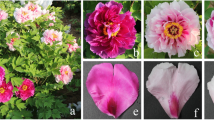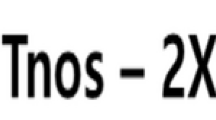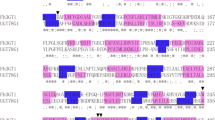Abstract
Flavonoid 3′,5′-hydroxylase (F3′5′H) is the key enzyme for the expression of blue or purple flower color. A full-length cDNA for the F3′5′H gene was cloned from petals of Vinca major, and its genomic clone, designated VmFH1 (accession number AB078781 in the GenBank/EMBL/DDBJ databases), was isolated from leaves by a PCR-based strategy. Nucleotide sequence analysis revealed that VmFH1 contains one intron and an open reading frame encoding a polypeptide of 506 amino acid residues. The deduced amino acid sequence shows between 51% and 83% identity with those of previously reported F3′5′H genes. Southern blot analysis showed that there are 3–4 copies of the F3′5′H gene in the genome of V. major. Transcripts of the F3′5′H gene were detected in young flower petals but not in leaves as revealed by RT-PCR analysis. When VmFH1 was expressed in transgenic Petunia hybrida under the control of the cauliflower mosaic virus 35S promoter, some transgenic plants showed drastic flower color alteration from red to deep red with deep purple sectors. These transgenic plants accumulated 3′,5′-hydroxylated anthocyanins in their petals, which were never detected in non-transgenic plants by high-performance liquid chromatography analysis. These results indicate that VmFH1 isolated from V. major encodes F3′5′H and is active in a heterologous plant species.







Similar content being viewed by others
Abbreviations
- CaMV :
-
Cauliflower mosaic virus
- DFR :
-
Dihydroflavonol 4-reductase
- F3′H :
-
Flavonoid 3′-hydroxylase
- F3′5′H :
-
Flavonoid 3′,5′-hydroxylase
- GUS :
-
β-Glucuronidase
- MS :
-
Murashige and Skoog medium
- ORF :
-
Open reading frame
- PCR :
-
Polymerase chain reaction
- RACE :
-
Rapid amplification of cDNA ends
- RT-PCR :
-
Reverse transcription-polymerase chain reaction
References
Chapple C (1998) Molecular-genetic analysis of plant cytochrome P450-dependent monooxygenases. Annu Rev Plant Physiol Plant Mol Biol 49:311–343
Dixon RA, Steele CL (1999) Flavonoids and isoflavonoids—a gold mine for metabolic engineering. Trends Plant Sci 4:394–400
Forkmann G (1991) Flavonoids as flower pigments: the formation of the natural spectrum and its extension by genetic engineering. Plant Breed 106:1–26
Forkmann G, Martens S (2001) Metabolic engineering and applications of flavonoids. Curr Opin Biotechnol 12:155–160
Forkmann G, Ruhnau B (1987) Distinct substrate specificity of dihydroflavonol 4-reductase from flowers of Petunia hybrida. Z Naturforsch 42c:1146–1148
Holton TA, Brugliera F, Lester DR, Tanaka Y, Hyland CD, Menting JGT, Lu C-Y, Farcy E, Stevenson TW, Cornish EC (1993) Cloning and expression of cytochrome P450 genes controlling flower colour. Nature 366:276–279
Horsch RB, Fry JE, Hoffmann NL, Eichholtz D, Rogers SG, Fraley RT (1985) A simple and general method for transferring genes into plants. Science 227:1229–1231
Jefferson RA, Kavanagh TA, Bevan MW (1987) GUS fusions: β-glucuronidase as a sensitive and versatile gene fusion marker in higher plants. EMBO J 13:3901–3907
Kaltenbach M, Schröder G, Schmelzer E, Lutz V, Schröder J (1999) Flavonoid hydroxylase from Catharanthus roseus: cDNA, heterologous expression, enzyme properties and cell-type specific expression in plants. Plant J 19:183–193
Mori S, Asano S, Kobayashi H, Nakano M (2002) Analyses of anthocyanidins and anthocyanins in flowers of Muscari spp. Bull Fac Agric Niigata Univ 55:13–18
Murashige T, Skoog F (1962) A revised medium for rapid growth and bioassays with tobacco tissue cultures. Physiol Plant 15:473–497
Nielsen KM, Podivinsky E (1997) cDNA cloning and endogenous expression of a flavonoid 3′5′-hydroxylase from petals of lisianthus (Eustoma grandiflorum). Plant Sci 129:167–174
Ochman H, Gerber AS, Hartl DL (1988) Genetic applications of an inverse polymerase chain reaction. Genetics 120:621–625
Ohta S, Mita S, Hattori T, Nakamura K (1990) Construction and expression in tobacco of β-glucuronidase (GUS) reporter gene containing an intron within the coding sequence. Plant Cell Physiol 31:805–813
Page RDM (1996) TREEVIEW: an application to display phylogenetic trees on personal computers. Comput Appl Biosci 12:357–358
Rogers SO, Bendich AJ (1985) Extraction of DNA from milligram amounts of fresh, herbarium and mummified plant tissue. Plant Mol Biol 5:69–79
Sambrook J, Fritsch EF, Maniatis T (1989) Molecular cloning: a laboratory manual. Cold Spring Harbor Laboratory Press, Cold Spring Harbor, N.Y.
Sanger F, Nicklen S, Coulson AR (1977) DNA sequencing with chain terminating inhibitors. Proc Natl Acad Sci USA 74:5463–5467
Shimada Y (2000) Flower color engineering with flavonoid-biosynthetic genes. Chem Regul Plants 35:138–148
Shimada Y, Nakano-Shimada R, Ohbayashi M, Okinaka Y, Kiyokawa S, Kikuchi Y (1999) Expression of chimeric P450 genes encoding flavonoid-3′,5′-hydroxylase in transgenic tobacco and petunia plants. FEBS Lett 461:241–245
Shimada Y, Ohbayashi M, Nakano-Shimada R, Okinaka Y, Kiyokawa S, Kikuchi Y (2001) Genetic engineering of the anthocyanin biosynthetic pathway with flavonoid-3′5′-hydroxylase: specific switching of the pathway in petunia. Plant Cell Rep 20:456–462
Suzuki S, Nakano M (2002) Agrobacterium-mediated production of transgenic plants of Muscari armeniacum Leichtl. ex Bak. Plant Cell Rep 20:835–841
Suzuki K, Xue H, Tanaka Y, Fukui Y, Fukuchi-Mizutani M, Murakami Y, Katsumoto Y, Tsuda S, Kusumi T (2000) Flower color modifications of Torenia hybrida by cosuppression of anthocyanin biosynthesis genes. Mol Breed 6:239–246
Tanaka Y, Yonekura K, Fukuchi-Mizutani M, Fukui Y, Fujiwara H, Ashikari T, Kusumi T (1996) Molecular and biochemical characterization of three anthocyanin synthetic enzymes from Gentiana triflora. Plant Cell Physiol 37:711–716
Tanaka Y, Tsuda S, Kusumi T (1998) Metabolic engineering to modify flower color. Plant Cell Physiol 39:1119–1126
Thompson JD, Higgins DG, Gibson TJ (1994) CLUSTAL W: improving the sensitivity of progressive multiple sequence alignment through sequence weighting, position-specific gap penalties and weight matrix choice. Nucleic Acids Res 22:4673–4680
Toguri T, Azuma M, Ohtani T (1993a) The cloning and characterization of a cDNA encoding a cytochrome P450 from the flowers of Petunia hybrida. Plant Sci 94:119–126
Toguri T, Umemoto N, Kobayashi O, Ohtani T (1993b) Activation of anthocyanin synthesis genes by white light in eggplant hypocotyl tissues, and identification of an inducible P-450 cDNA. Plant Mol Biol 23:933–946
Triglia T, Peterson MG, Kemp DJ (1988) A procedure for in vitro amplification of DNA segments that lie outside the boundaries of known sequences. Nucleic Acids Res 16:8186
Ueyama Y, Suzuki K, Fukuchi-Mizutani M, Fukui Y, Miyazaki K, Ohkawa H, Kusumi T, Tanaka Y (2002) Molecular and biochemical characterization of torenia flavonoid 3′-hydroxylase and flavone synthase II and modification of flower color by modulating the expression of these genes. Plant Sci 163:253–263
Vetten N de, ter Horst J, van Schaik HP, de Boer A, Mol J, Koes R (1999) A cytochrome b 5 is required for full activity of flavonoid 3′,5′-hydroxylase, a cytochrome P450 involved in the formation of blue flower colors. Proc Natl Acad Sci USA 96:778–783
Wiering H, Vlaming PD (1984) Genetics of flower and pollen colors. In: Sink KC (ed) Petunia. Springer, Berlin Heidelberg New York, pp 49–67
Acknowledgement
We gratefully acknowledge Mr. S. Asano, Niigata Agricultural Research Institute, for his valuable suggestions on anthocyanin extraction and HPLC analysis.
Author information
Authors and Affiliations
Corresponding author
Additional information
Communicated by P. Lakshmanan
Rights and permissions
About this article
Cite this article
Mori, S., Kobayashi, H., Hoshi, Y. et al. Heterologous expression of the flavonoid 3′,5′-hydroxylase gene of Vinca major alters flower color in transgenic Petunia hybrida . Plant Cell Rep 22, 415–421 (2004). https://doi.org/10.1007/s00299-003-0709-3
Received:
Revised:
Accepted:
Published:
Issue Date:
DOI: https://doi.org/10.1007/s00299-003-0709-3




